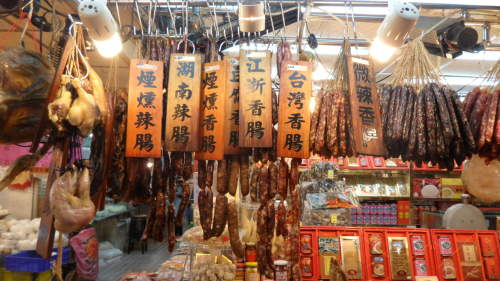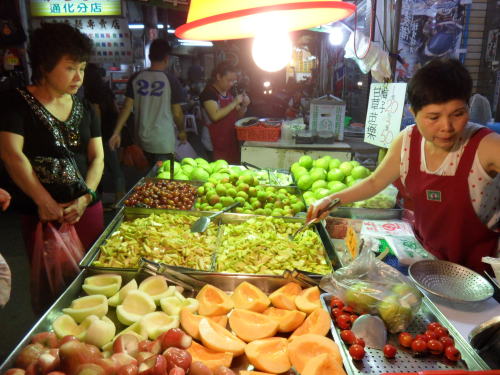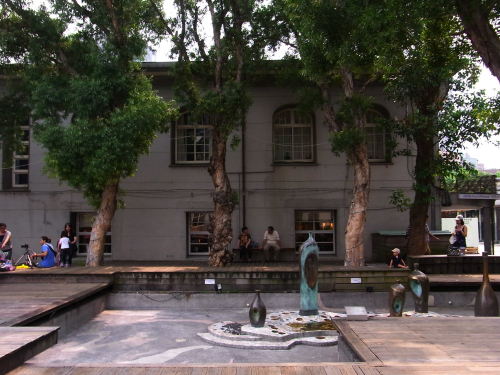Taipei offers exotic tradition as well as vibrant youth culture
TAIPEI ― Taipei is a city of red and green.
It’s red because a traditional food market, a Buddhist temple and a bustling night market are all colored very much with the redness of foods, red Buddhist lanterns and reddish wax apples. It’s green because the Taiwanese capital’s clean streets and roads are almost always decorated with green trees and its wine-factory-turned creative park offers plenty of relaxation and nature for young Taiwanese contemporary artists.
The city changes its face every minute, depending on which area you are really interested in looking at.
Red for tradition
It is no exaggeration that many local Taiwanese start their days at the Nan Men Market, one of the most well-known morning markets in the country. It is open at 7 p.m. and working Taipei citizens often drop by the market before they head to their office.
 |
A variety of dried hams and sausages hang from the ceiling at a shop at the Nan Men Market. (Kim Yoon-mi/The Korea Herald) |
As soon as you enter the market inside a small three-story building, you will face so many exotic and rare foods that you cannot even guess what their names are.
A vendor was selling a variety of sausages, hams, dried fish, raw fish and chickens all dangling under a steel bar at the entrance of the market.
You can even see skinned chickens with their heads and the cockscombs still hanging.
The vendor handed over a slice of pork jerky for a try, and it was quite sweet.
If you want to buy something for your families or friends at home but avoid risky foods in terms of taste, dried papaya will be a wise choice. It’s not that expensive either. Jelly-type “turtle-shell” snacks, which vendors said were good for your health, tasted like herbal medicine but weren’t bitter.
The end of the food market was the area for selling stinky tofu. If your nose is more sensitive to exotic odors than others, it’d be better to hold your breath.
After trying some traditional foods, you can check a temple nearby, called The Longshan Temple (Dragon Mountain Temple).
From outside, the temple ― decorated with red-tiled roofs and so many dragons ― looks very quiet.
But once you step inside, you’ll face a lot of locals praying, chanting a song in groups and making various offerings, including food gifts to different Buddhas.
Taoism is a major religion in Taiwan but the Buddhist temple is a place to wishfor fortune in a career, wealth and relationship, according to locals.
Surprisingly, many young couples brought and burned their incenses to a Buddha, praying for their relationship.
Into the night, it gets more exciting in Taipei. The Tung Hua Street Market begins with the odor of tofu but once you get past that, hundreds of shopping items and street snacks spread out in front of your eyes.
 |
A vendor sells fruits at the Tung Hua Night Market. (Kim Yoon-mi/The Korea Herald) |
Crowded by people, the market becomes especially lively with some haggling over prices for fresh apples and some illegal vendors rushing their carts to avoid the police.
A large pack of wax apples ― common fruit in Taiwan ― only cost $5 and it’s good to nibble them while wondering around the street market.
The best part of the market was a semi-outdoor food massage service. A full, 40-minute massage, from the hot water washing to the painful but beneficial foot and leg massages to the final hot towel wraps around your legs, cost only $17.
Green for youth
In contrast to the traditional Taipei, there is also a young and hip side to the city.
The Huashan 1914 Creative Park is the place for Taiwanese youth hold contemporary art exhibitions, enjoy brunch or read at a caf, buy paintings at a gallery or do yoga.
 |
People rest at the Huashan 1914 Creative Park.(Kim Yoon-mi/The Korea Herald) |
The area was once a sake factory under Japanese rule (1895-1945) and then was abandoned until 1997, when a Taiwanese theater performance group discovered the place. Since then, artists and NGO activists have pushed for it to become an arts center. In 2005, the rebuilding of the Creative Park officially began. Under the Taiwanese government, Taiwan Cultural-Creative Development Co. Ltd. has been operating the park since 2007.
Because the buildings had been abandoned for quite some time, they’re partly covered with green leaves, stretching from branches of trees that have grown for so many years. The old Japanese architecture and the natural greens make a unique atmosphere.
Inside the park, you can see a tall chimney that had been used for making wine. It used to be the tallest structure until the iconic 101 Tower was built.
Some groups of Taiwanese university students were holding their graduation art exhibitions at the park, while other youngsters were sitting outside a building waiting for a concert by a famous Taiwanese rock band.
Several design shops were selling inspiring and creative art works as well.
The Tea Street shouldn’t be missed out when checking out Taipei’s youth culture. Young Taiwanese can be easily seen sitting at a bubble tea caf on the Tea Street, mostly chatting or playing cards. Two teenage-looking girls were smoking a cigarette, with a bubble tea on their table.
An iced bubble tea, with a normal size coming at 0.6 liter ― costs about $4 at a caf and $1 on the street.
When you order a bubble tea, you should make clear about three things ― how sweet you want your tea to be, iced or not-iced and little pearls or big pearls.
By Kim Yoon-mi, The Korea Herald correspondent
(
yoonmi@heraldcorp.com)










![[Today’s K-pop] Blackpink’s Jennie, Lisa invited to Coachella as solo acts](http://res.heraldm.com/phpwas/restmb_idxmake.php?idx=644&simg=/content/image/2024/11/21/20241121050099_0.jpg)